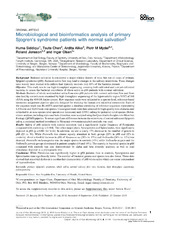| dc.contributor.author | Siddiqui, Huma | en_US |
| dc.contributor.author | Chen, Tsute | en_US |
| dc.contributor.author | Aliko, Ardita | en_US |
| dc.contributor.author | Mydel, Piotr Mateusz | en_US |
| dc.contributor.author | Jonsson, Roland | en_US |
| dc.contributor.author | Olsen, Ingar | en_US |
| dc.date.accessioned | 2016-11-25T10:16:11Z | |
| dc.date.available | 2016-11-25T10:16:11Z | |
| dc.date.issued | 2016-10-20 | |
| dc.Published | Journal of Oral Microbiology 2016, 8:31119 | eng |
| dc.identifier.issn | 2000-2297 | |
| dc.identifier.uri | https://hdl.handle.net/1956/13118 | |
| dc.description.abstract | Background: Reduced salivation is considered a major clinical feature of most but not all cases of primary Sjögren’s syndrome (pSS). Reduced saliva flow may lead to changes in the salivary microbiota. These changes have mainly been studied with culture that typically recovers only 65% of the bacteria present. Objective: This study was to use high throughput sequencing, covering both cultivated and not-yet-cultivated bacteria, to assess the bacterial microbiota of whole saliva in pSS patients with normal salivation. Methods: Bacteria of whole unstimulated saliva from nine pSS patients with normal salivation flow and from nine healthy controls were examined by high throughput sequencing of the hypervariable region V1V2 of 16S rRNA using the 454 GS Junior system. Raw sequence reads were subjected to a species-level, reference-based taxonomy assignment pipeline specially designed for studying the human oral microbial community. Each of the sequence reads was BLASTN-searched against a database consisting of reference sequences representing 1,156 oral and 12,013 non-oral species. Unassigned reads were then screened for high-quality non-chimeras and subjected to de novo species-level operational taxonomy unit (OTU) calling for potential novel species. Downstream analyses, including alpha and beta diversities, were analyzed using the Quantitative Insights into Microbial Ecology (QIIME) pipeline. To reveal significant differences between the microbiota of control saliva and Sjögren’s saliva, a statistical method introduced in Metastats www.metastats.cbcb.umd.edu was used. Results: Saliva of pSS patients with normal salivation had a significantly higher frequency of Firmicutes compared with controls (p=0.004). Two other major phyla, Synergistetes and Spirochaetes, were significantly depleted in pSS (p=0.001 for both). In addition, we saw a nearly 17% decrease in the number of genera in pSS (25 vs. 30). While Prevotella was almost equally abundant in both groups (25% in pSS and 22% in controls), about a twofold increase in pSS of Streptococcus (28% vs. 17%) and Veillonella (26% vs. 12%) was detected. Prevotella melaninogenica was the major species in controls (13%) while Veillonella atypica and the Veillonella parvula groups dominated in patient samples (14 and 14%). The scarcity in bacterial species in pSS compared with controls was also demonstrated by alpha and beta diversity analyses, as well as read abundance depicted in a phylogenetic tree. Conclusions: While Firmicutes was significantly higher in pSS patients than in controls, Synergistetes and Spirochaetes were significantly lower. The number of bacterial genera and species was also lower. These data showed that microbial dysbiosis is another key characteristic of pSS whole saliva which can occur independent of hyposalivation. | en_US |
| dc.language.iso | eng | eng |
| dc.publisher | Co-Action Publishing | eng |
| dc.rights | Attribution CC BY-NC | eng |
| dc.rights.uri | http://creativecommons.org/licenses/by-nc/4.0/ | eng |
| dc.subject | primary Sjögren’s syndrome | eng |
| dc.subject | whole saliva | eng |
| dc.subject | normal salivary flow rate | eng |
| dc.subject | bacteria | eng |
| dc.subject | high throughput sequencing | eng |
| dc.subject | pyrosequencing | eng |
| dc.title | Microbiological and bioinformatics analysis of primary Sjogren's syndrome patients with normal salivation | en_US |
| dc.type | Peer reviewed | |
| dc.type | Journal article | |
| dc.date.updated | 2016-10-22T08:15:57Z | |
| dc.description.version | publishedVersion | en_US |
| dc.rights.holder | Copyright 2016 The Authors | |
| dc.identifier.doi | https://doi.org/10.3402/jom.v8.31119 | |
| dc.identifier.cristin | 1393655 | |

